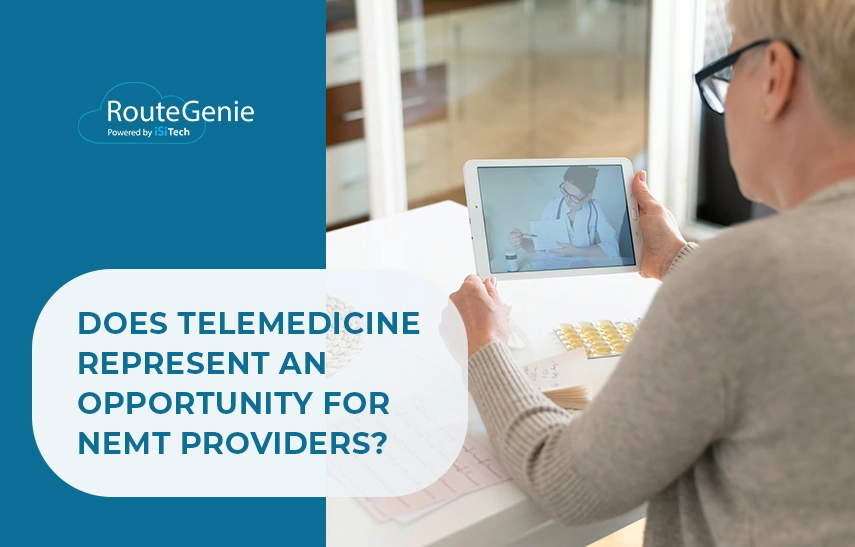Does Telemedicine Represent an Opportunity for NEMT Providers?

Non-emergency medical transport (NEMT) providers take care of patients with mobility issues. In fact, this is what the industry is founded on. It centers on providing safe, comfortable transportation to passengers who require special care.
These mobility issues may render some patients unable to leave their homes. That’s where the power of technology comes in. Advancements in communication have powered the growth of telemedicine.
Telemedicine and e-health use advanced technology to deliver remote healthcare services to patients. Despite its origins in American medicine going back to the 1960s, it is still in the beginning stages. Telemedicine saw an explosion of growth in 2019 and 2020. The COVID-19 pandemic made virtual healthcare appointments necessary.
As the digital health sector continues to grow, telehealth and telemedicine expand with it. This is a new frontier for healthcare. It is rich with opportunities for all stakeholders, including NEMT providers.
Contents:
- Understanding Telemedicine and Telehealth
- Future Trends in Telemedicine
- Limitations of Telemedicine
- Telemedicine, Telehealth and NEMT: a Shared Future
- Best Practices for Telemedicine Providers
- Why Telemedicine is Important for NEMT Providers
- Conclusion
Understanding Telemedicine and Telehealth
At first glance, telemedicine and telehealth seem to be interchangeable terms. The American Telemedicine Association considers the two synonymous. However, they are two different fields under the larger umbrella of digital health.
As two elements of a larger whole, both involve delivering quality healthcare virtually. Another similarity is that they rely heavily on advanced technology.
So, what sets telemedicine apart from telehealth? To better understand the finer distinctions, let’s break down the terms:
- Digital Health: The sector that encompasses digital technologies in healthcare.
- Telemedicine: The use of technology to ensure better access to medical information and patient care.
- Telehealth: Using virtual technology to deliver basic healthcare outside traditional facilities.
- eHealth: The use of information and communication technology for healthcare.
- mHealth: Using mobile wireless technology for healthcare.
These definitions for digital health-related are formulated by the World Health Organization (WHO). They illustrate the key difference: their ultimate objective.
Telemedicine seeks to improve patient outcomes. Telehealth seeks to improve access to healthcare services. Both aim to make it easier for healthcare providers to deliver top-notch patient care.
Future Trends in Telemedicine
As technology evolves, more patients and healthcare providers will turn to telemedicine. Today, 76% of hospitals in the United States treat patients with some form of telemedicine. That is a two-fold increase from 35% of hospitals in 2010.
Before COVID-19, neurology, radiology, and cardiology saw the most use of telemedicine. In recent years, more and more mental health professionals and therapists have turned to remote sessions.
Telemedicine is full of potential. In the near future, the following trends will shape the landscape of telemedicine and telehealth:
Overall Adoption
One of the benefits of telemedicine is that it helps providers service more patients than they can in person. Virtual processes manage an unprecedented number of patients each day.
The COVID-19 pandemic also demonstrated the value of telemedicine. All patients and their physicians were kept safe and distanced.
These advantages have driven an increase in telemedicine adoption across the healthcare sector. This is evidenced by the exponential growth in the last few years.
Reforms and Regulations
With increased adoption will come increased recognition. In 2019, the Center for Medicaid Services (CMS) expanded access to telemedicine at the same rate as in-person visits.
Each state has different regulations about the telemedicine services offered under Medicaid. This will be revisited in years to come.
Insurance companies are also revising their policies to include telemedicine in their coverage.
Technology Integration
Smartphones, video conferencing software, and healthcare apps have revolutionized telemedicine. And as a field driven by innovation, its capabilities are set to increase. After all, technology is evolving rapidly.
Autonomous cars and ride digitization are expected to make waves in healthcare transport. These are two good examples of the promise of technology in medicine.
Reduced Costs
A common perception is that telemedicine is more expensive than in-person visits. After all, advanced tech and software are involved. Surely stepping into a doctor’s office is cheaper?
So does telemedicine reduce costs? The truth is that telemedicine is more affordable than ever. In fact, virtual appointments reduce expenses. And it does so for patients and healthcare facilities alike.
Ease of Accessing Telemedicine Services
Telemedicine services remove one of the biggest barriers to accessing healthcare - transportation. Since patients don't need to go there and can access appointments from their homes, it's great for those who don't have a vehicle, live too far, etc.
Limitations of Telemedicine
 Despite the exciting possibilities telemedicine offers, there are still growing pains. Gaps in the existing ecosystem can lead to compromises in service.
Despite the exciting possibilities telemedicine offers, there are still growing pains. Gaps in the existing ecosystem can lead to compromises in service.
Here are some of the biggest limitations of telemedicine today:
Lack of Awareness Among Consumers and Providers
There is tremendous potential for delivering remote healthcare to a vast number of patients. Unfortunately, awareness about telemedicine is not widespread. And it’s not just on the consumer end.
Healthcare providers and insurance companies have not embraced telemedicine on a mass scale. Federal and state bodies are slow to adapt, too.
Lack of Access
Before it was mentioned that telemedicine gives access to healthcare by removing some of the barriers, but telemedicine relies on certain hardware and software. This means access to remote care is limited to those with access to this technology. In remote and rural locations, the lack of infrastructure means telemedicine is not viable.
Without a good internet connection, there is no way for patients to access robust remote healthcare services.
Lack of Human Interaction
Telemedicine and e-health leverage mobile apps to connect healthcare providers to patients. This intermediary link can lead to miscommunication and a lack of understanding.
For now, there are still many cases where telemedicine cannot replace in-person consultations. Some diagnoses still require physical examinations and sometimes during in-person checkups some diseases can be found.
Certain specialties like psychiatry are well-suited to telemedicine. But not all types of patient care can be done entirely online.
Compromised Privacy
Patients’ health information is highly sensitive. Telemedicine apps that collect this data must be secure. They must not expose this data to cyberattackers. Unfortunately, not all apps are secure. Without proper verification and certification, patients will have doubts about the security of their data. Privacy policies must be communicated clearly to instill faith in telemedicine.
Overcoming these limitations can be challenging. Partnering with other healthcare stakeholders can bridge these gaps.
One healthcare field that is ripe for collaboration with telemedicine is NEMT.
Telemedicine, Telehealth and NEMT: a Shared Future
Telemedicine + Telehealth and NEMT services are not mutually exclusive. With the limitations of telemedicine and telehealth, NEMT providers can provide relief.
NEMT and telemedicine services can complement each other. Despite worries that telemedicine would erode the market for NEMTs, the two can easily co-exist.
The future of telemedicine and NEMT services are intertwined. Here’s how:
How Can NEMT Providers Stay Profitable When Telemedicine Boosts
NEMT providers have worried about losing customers to telemedicine. But it’s more productive to focus on making it work in their favor. Leveraging telemedicine and telehealth can lead to advancements in the NEMT industry.
Digital health tools like management software are essential to efficient NEMT operations.
NEMT software like RouteGenie can improve capabilities in the following ways:
Patient portal
A portal within NEMT software is a direct line of communication between patients and providers. Patients can schedule all appointments and review previous trips.
Patient records
NEMT providers can maintain a database of their patients and their requirements. By keeping track of their patients' regular appointments and checkups, NEMT providers can ensure timely and efficient transportation services. The database can also help them schedule pick-ups and drops with greater accuracy and ease, reducing the chances of any delays or missed appointments. Passengers can have their preferred drivers, so they are more satisfied with the service and don’t switch providers. With a patient-focused approach that prioritizes their unique needs, NEMT providers can deliver a specialized level of care that promotes better health outcomes and overall satisfaction for their patients.
Patient care
Telemedicine has reduced the need for in-person appointments. Through virtual consultations, patients with chronic conditions can talk to their physicians from the comfort of their homes.
However, some procedures and consultations require in-person trips to a healthcare facility. NEMT providers are readily available to facilitate these appointments. They are ready to provide everything the patient needs for a comfortable journey.
In-Person Visits
Telemedicine works to provide healthcare remotely, but some in-person visits cannot be skipped. Patients requiring physical examinations or treatments such as dialysis and chemotherapy sessions must go to their appointments. NEMT providers can supplement the remote healthcare benefits of telemedicine in this scenario.
Improved Efficiency and Results
When telemedicine treatments are supported by regular in-person visits to their, patients benefit from the full spectrum of medical attention. Leveraging the complementary benefits of telemedicine and NEMT services deliver a better standard of healthcare and makes it more accessible. In turn, this improves patient outcomes.
Technological Advantage
Adopting new technology reduces the risk of human error in record-keeping and appointment scheduling. Newer telemedicine tools and NEMT software give healthcare providers a 21st-century technological advantage.
Best Practices for Telemedicine Providers
 A partnership between NEMT and telemedicine providers can be mutually beneficial. NEMT companies must choose the best-suited telemedicine providers to work with.
A partnership between NEMT and telemedicine providers can be mutually beneficial. NEMT companies must choose the best-suited telemedicine providers to work with.
Here are some industry best practices to keep in mind:
- Telemedicine services should meet all clinical and professional standards mandated by the profession. This includes federal and state regulatory boards and federal and state law.
- Telemedicine providers must have the appropriate license, credentials, and certification to operate their practice.
- Telehealth and telemedicine service providers must ensure cybersecurity across all their platforms. This includes all systems and devices. HIPAA compliance is a must.
- All advertisements for a telemedicine service must not be misleading. Marketing collateral must be truthful and in compliance with state and federal law.
Why Telemedicine is Important for NEMT Providers
We’ve outlined how telemedicine provides advantages to the healthcare sector. When NEMT providers leverage this technology, they can expect to reap benefits. Working with reputable telemedicine providers can take their enterprise to another level.
Here is a summary of why telemedicine is important for NEMT providers:
- Ensures preparedness in case of an emergency
- Enables more efficient operations, which leads to long-term growth and success
- Leads to smarter resource utilization and management
- Enhances the quality of patient care, meaning that the industry will have more high quality TPs
- Provides opportunities to network with other healthcare stakeholders.
Conclusion
NEMT providers should treat the rise of telemedicine solutions as a positive. After all, it grants all healthcare stakeholders greater control over how they deliver their services.
The need to use telemedicine in the NEMT industry is increasing. Forward-thinking providers must grab this opportunity to take their operations to the next level. This will only benefit the company and the patients they serve.
When these two fields intersect, telemedicine and NEMT providers can arrive at a win-win situation
About the author
An experienced content writer, Keren Dinkin’s forte is writing well-informed medical transportation, healthcare accounting, and related articles. Her work is backed by months of intensive research and pays meticulous attention to details. In addition to being a writer, she also dons the hat of a content strategist. The author assumes no responsibility or liability for any errors or omissions in the content of this site. The information contained in this site is provided on an "as is" basis with no guarantees of completeness, accuracy, usefulness or timeliness.